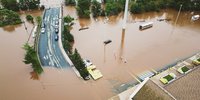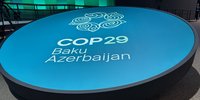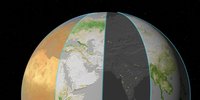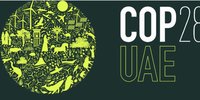Aerosol particles in the atmosphere have an important influence on the Earth's radiative balance by directly reflecting sunlight back into space, as well as absorbing some sunlight and converting it into heat. Aerosols also have an impact on climate by acting as cloud condensation nuclei, which alters cloud properties and their radiative effects. Aerosol particles at surface level impact human health, and are associated with disruption to transport (desert dust storms and volcanic eruptions) and can reduce the solar irradiance available for solar power plants.
Objective
The driving objective of the CCI Aerosol project is to provide independently validated, high quality algorithms for processing long-term records of global aerosol properties from European satellite instruments.
The current Aerosol project, running May 2025 to December 2026, focuses on completing algorithm improvements for the dual view sensor line, in particular the Sentinel-3 SLSTR instrument together with one user case study (data assimilation for climate services) and community support (AEROSAT coordination support). Another user case study is linked in the ESA Cliamte-Space cross-ECV project SATACI (feasibility study for an aerosol and cloud cooling offset climate indicator).
The processing of long-term records (6-monthly extensions and complete reprocessing every 2-3 years) has been transferred to the Copernicus Climate Change Service since 2018 within the contracts C3S_312a_Lot5 (October 2016 – September 2018), C3S_312b_Lot2 (October 2018 – June 2021), C3S2_312a_Lot2 (November 2021 - April 2024) and C3S2_313a (June 2025 - December 2027).
In response to the requirements of the Global Climate Observing System (GCOS) and the AEROCOM international modelling community, the three former phases of the Aerosol have focused on:
- Improving and assessing algorithms for total aerosol optical depth
- Improving and assessing algorithms for fine / coarse mode aerosol optical depth and for dust optical depth
- Improving and assessing algorithms for stratospheric extinction profiles
- Testing algorithms for further aerosol quantitates (effective layer height, single scattering albedo / absorbing aerosol optical depth)
- Working with the AEROCOM community as a primary user and conducting ten dedicated user case studies on the applicability of those data sets, their strengths and weaknesses.
Aerosol Phase 1 ran July 2010 to February 2014; Phase 2 ran May 2014 to October 2019. Aerosol_cci+ Phase 1 extended from March 2019 to July 2022.
The latest global Aerosol_cci products including uncertainties are provided via the CCI Open Data Portal:
Since operational continuation of data (re-)processing has been transfer to the Copernicus Climate Change Service, more recent versions of updated / improved data records (also including successor sensors SLSTR and OLCI) are available at the Copernicus Climate Data Store
Latest mature Aerosol_cci data records
- AATSR_ADV and ATSR2_ADV / v2.31 AOD, FMAOD 1995-2012 (FMI)
- AATSR_ORAC and ATSR2_ORAC / v4.01 AOD, FMAOD 1995-2012 (Oxford University / RAL)
- AATSR_SU and ATSR_SU / v4.3 AOD, FMAOD 1995-2012 (Swansea University)
- AATSR and ATSR2 uncertainty-weighted ensemble v2.6 (DLR)
- IASI_ULB / v8 Dust AOD 2007-2015 (ULB), available on request
- IASI_LMD / v2.1 Dust AOD 2007-2015 (LMD), available on request
- IASI_IMARS / v5.2 Dust AOD 2007-2015 (DLR), available on request
- IASI_MAPIR / v3.51 Dust AOD 2007-2015 (BIRA), available on request
- PARASOL_GRASP v0.08 AOD, FMAOD, SSA 2005-2013, 4 selected regions (LOA), available on request
- GOMOS_AERGOM / v3.00 stratospheric extinction 2002-2012 (BIRA)
Additional Aerosol_cci data records
- MERIS_ALAMO / v2.2 AOD 1-12 2008, ocean only (ICARE)
- Multi-sensor AAI / v1.7 1978-2012 (KNMI, co-funded by Aerosol_cci)
- SEVIRI CISAR data set v10 2008 is provided (experimental, available on request), available on request
Main dataset characteristics
The four AATSR data sets are similar in their quality over land to MODIS / MISR but with weaker coverage and less accuracy for high AOD values. The four ATSR-2 data sets cover a historic period observed by few other satellite aerosol sensors.
The four IASI datasets contain a complementary aerosol property (mineral dust AOD).
PARASOL / GRASP provides several consistent aerosol properties within one retrieval: AOD, Fine Mode AOD, Single Scattering Albedo.
GOMOS / AERGOM provides stratospheric extinction profile data sets.
The multi-sensor AAI record provides qualitative information on aerosol absorption.
The MERIS data set provides wider swath width than AATSR (both on-board ENVISAT).
The SEVIRI CISAR algorithm provides hourly AOD.
At the end of the Aerosol_cci+ Phase 1 project (2019 - 2022), the following key documents have been approved by ESA:
The Aerosol project team is composed of following partners:
Project Coordination
German Aerospace Center (DLR)
Dr. Thomas Popp is science leader and project manager.
EO Expert Team (retrieval development and validation)
Swansea University (SU)
- Dr. Peter North and his team are focusing on further improving the SLSTR (and ATSR) retrieval algorithms used in Aerosol_CCI2.
- Dr. Marta Luffarelli and her team are working on a new SLSTR retrieval CISAR based on SEVIRI heritage.
German Aerospace Center (DLR)
- Dr. Thomas Popp and his team are working on the validation of aerosol data sets with AERONET and coordinates the AEROSAT network.
Finnish Meteorological Institute (FMI)
- Drs. Larisa Sogacheva is working on inter-comparisons of aerosol data sets with other satellite-based data sets and extends the merged community AOD dataset.
Climate Modelling Team
German Aerospace Center (DLR), consultant
- Dr. Stefan Kinne is consulting the project with his wide expertise from user perspective working with both aerosol model and satellite datasets.
European Centre for Medium Range Weather Forecasts (ECMWF) - in-kind contribution
- Dr. Enza Di Tomaso will repeat the user case study for data assimilation of the updated SLSTR aerosol data linking to the data assimilation / forecasting / climate service communities.
The Aerosol project is rooted deeply into the developments of its predecessor project. Aerosol phase 1 and phase 2 project teams were composed of following partners:
- German Aerospace Center (DLR): Drs. Thomas Popp (co science leader, project manager), Miriam Kosmale (dpt. project manager), Lars Klüser (EO experts), Julian Meyer-Arnek (system engineer).
- Finnish Meteorological Institute (FMI): Prof. Dr. Gerrit de Leeuw (co science leader), Drs. Larisa Sogacheva, Pekka Kolmonen (EO experts).
- Oxford University (UO): Drs. Don Grainger, Adam Povey (EO experts)
- Rutherford Appleton Laboratory (RAL): Drs. Caroline Poulson, Gareth Thomas, (EO experts), Richard Siddans (system engineer)
- Swansea University (SU): Drs. Peter North, Andreas Heckel (EO experts)
- University of Bremen (UB): Drs. Marco Vountas, Linlu Mei (EO experts)
- Lille University - Laboratoire d'Optique Atmosphérique (LOA): Prof. Dr. Oleg Dubovik, Drs. Pavel Litvinov (EO experts), Jacques Descloitres (system engineer)
- Royal Netherlands Meteorological Institute (KNMI): Drs. Pepijn Veefkind, Gijsbert Tilstra (EO experts, user).
- Belgian Institute for Space Aeronomie (BIRA): Drs. Christine Bingen, Sophie Vandebussche (EO experts)
- Rayference: Dr. Yves Govaerts (EO expert)
- Universite Libre de Brussels: Prof. Lieven Clarisse (EO expert)
- Ecole Polytechnique (LMD): Dr. Virginie Capelle (EO expert)
- Norwegian Meteorological Institute (MetNo): Drs. Michael Schulz, Jan Griesfeller (user, validation expert)
- Max-Planck Institute for Meteorology (MPI): Drs. Stefan Kinne, Christoph Brühl (user, validation expert)
- Norwegian Institute for Air Reearch (NILU): Dr. Kerstin Stebel (validation expert)
- Eidgenössische Technische Hochschule Zürich (ETHZ): Prof. Dr. Ulrike Lohmann, Dr. David Neubaur (user)
- Barcelona Supercomputing Center (BSC): Drs. Enza di Tomaso, Sara Basart (user)
- London Metropolitan University: Dr. Yong Xue (validation expert)
- Freie Universität Berlin (FUB): Prof. Dr. Jürgen Fischer, Dr. Rene Preusker (EO expert)
- HYGEOS: Dr. Didier Ramon (EO expert)
- Paul Scherrer Institut (PSI): Dr. Paul Zieger (validation expert)
Brühl, C., Schallock, J., Klingmüller, K., Robert, C., Bingen, C., Clarisse, L., Heckel, A., North, P., and Rieger, L.: Stratospheric aerosol radiative forcing simulated by the chemistry climate model EMAC using Aerosol CCI satellite data, Atmos. Chem. Phys., 18, 12845–12857, https://doi.org/10.5194/acp-18-12845-2018, 2018
de Leeuw, G., Sogacheva, L., Rodriguez, E., Kourtidis, K., Georgoulias, A. K., Alexandri, G., Amiridis, V., Proestakis, E., Marinou, E., Xue, Y., and van der A, R.: Two decades of satellite observations of AOD over mainland China using ATSR-2, AATSR and MODIS/Terra: data set evaluation and large-scale patterns, Atmos. Chem. Phys., 18, 1573–1592, https://doi.org/10.5194/acp-18-1573-2018, 2018.
Sogacheva, L., de Leeuw, G., Rodriguez, E., Kolmonen, P., Georgoulias, A. K., Alexandri, G., Kourtidis, K., Proestakis, E., Marinou, E., Amiridis, V., Xue, Y., and van der A, R. J.: Spatial and seasonal variations of aerosols over China from two decades of multi-satellite observations – Part 1: ATSR (1995–2011) and MODIS C6.1 (2000–2017), Atmos. Chem. Phys., 18, 11389–11407, https://doi.org/10.5194/acp-18-11389-2018, 2018.
Sogacheva, L., Rodriguez, E., Kolmonen, P., Virtanen, T. H., Saponaro, G., de Leeuw, G., Georgoulias, A. K., Alexandri, G., Kourtidis, K., and van der A, R. J.: Spatial and seasonal variations of aerosols over China from two decades of multi-satellite observations – Part 2: AOD time series for 1995–2017 combined from ATSR ADV and MODIS C6.1 and AOD tendency estimations, Atmos. Chem. Phys., 18, 16631–16652, https://doi.org/10.5194/acp-18-16631-2018, 2018.
Kylling, A., Vandenbussche, S., Capelle, V., Cuesta, J., Klüser, L., Lelli, L., Popp, T., Stebel, K., and Veefkind, P.: Comparison of dust layer heights from active and passive satellite sensors, Atmos. Meas. Tech., 11, 2911-2936, 2018, https://doi.org/10.5194/amt-11-2911-2018, 2018.
C. E. Bulgin, C. J. Merchant, D. Ghent, L. Klüser, T. Popp, C. Poulsen, L. Sogacheva, Quantifying Uncertainty in Satellite-Retrieved Land Surface Temperature from Cloud Detection Errors, Remote Sensing, 10(4), 616; https://doi.org/10.3390/rs10040616, 2018.
J. Christopher Kaiser, Johannes Hendricks, Mattia Righi, Patrick Jöckel, Holger Tost, Konrad Kandler, Bernadett Weinzierl, Daniel Sauer, Katharina Heimerl, Joshua P. Schwarz, Anne E. Perring, and Thomas Popp, Global aerosol modeling with MADE3 (v3.0) in EMAC (based on v2.53): model description and evaluation, Geoscientific Model Development, 12, 541–579, https://doi.org/10.5194/gmd-12-541-2019, 2019.
Sogacheva, L., Popp, T., Sayer, A. M., Dubovik, O., Garay, M. J., Heckel, A., Hsu, N. C., Jethva, H., Kahn, R. A., Kolmonen, P., Kosmale, M., de Leeuw, G., Levy, R. C., Litvinov, P., Lyapustin, A., North, P., Torres, O., and Arola, A.: Merging regional and global aerosol optical depth records from major available satellite products, Atmos. Chem. Phys., 20, 2031–2056, https://doi.org/10.5194/acp-20-2031-2020, 2020.
Sayer, A. M., Govaerts, Y., Kolmonen, P., Lipponen, A., Luffarelli, M., Mielonen, T., Patadia, F., Popp, T., Povey, A. C., Stebel, K., and Witek, M. L.: A review and framework for the evaluation of pixel-level uncertainty estimates in satellite aerosol remote sensing, Atmospheric Measurements and Techniques, 13, 373–404, https://doi.org/10.5194/amt-13-373-2020, 2020.
Popp Thomas, Michaela I. Hegglin, Rainer Hollmann, Fabrice Ardhuin, Annett Bartsch, Ana Bastos, Victoria Bennett, Jacqueline Boutin, Michael Buchwitz, Emilio Chuvieco, Philippe Ciais, Wouter Dorigo, Darren Ghent, Richard Jones, Thomas Lavergne, Christopher Merchant, Benoit Meyssignac, Frank Paul, Shaun Quegan, Tracy Scanlon, Marc Schröder, Stefan Simis, Ulrika Willén, Consistency of satellite climate data records for Earth system monitoring, Bulletin of the American Meteorological Society, 101 E1948–E1971., DOI10.1175/BAMS-D-19-0127.1, 2020
Luffarelli, Marta, Yves Govaerts, and Lucio Franceschini. 2022. “Aerosol Optical Thickness Retrieval in Presence of Cloud: Application to S3A/SLSTR Observations.” Atmosphere 13 (5): 691. https://doi.org/10.3390/atmos13050691
Thomas Popp, Johnathan Mittaz, Systematic propagation of AVHRR AOD uncertainties - a case study to demonstrate the FIDUCEO approach, Remote Sensing, 14, 875, https://doi.org/10.3390/rs14040875, 2022
Selected papers in the last few years which acknowledge Aerosol_cci and / or use Aerosol_cci data
Inness, A. et al., 2019: The CAMS reanalysis of atmospheric composition. Atmospheric Chemistry and Physics, 19(6), 3515–3556, doi:10.5194/acp-19-3515-2019
Kinne, S., 2019: Aerosol radiative effects with MACv2. Atmospheric Chemistry and Physics, 19(16), 10919–10959, doi:10.5194/acp-19-10919-2019
Gliß, J. et al., 2020: Multi-model evaluation of aerosol optical properties in the AeroCom phase III Control experiment, using ground and space based columnar observations from AERONET, MODIS, AATSR and a merged satellite product as well as surface in-situ observations from GAW. Atmos. Chem. Phys. Discuss., 2020, 1–62, doi:10.5194/acp-2019-1214
Gliß, J. et al., 2021: AeroCom phase III multi-model evaluation of the aerosol life cycle and optical properties using ground- and space-based remote sensing as well as surface in situ observations. Atmospheric Chemistry and Physics, 21(1), 87–128, doi:10.5194/acp-21-87-2021
Brühl, C., 2018: Volcanic SO2 data derived from limb viewing satellites for the lower stratosphere from 1998 to 2012, and from nadir viewing satellites for the troposphere. World Data Center for Climate (WDCC) at DKRZ, https://doi.org/10.1594/WDCC/SSIRC_1
The following links provide supporting information relating to the Aerosol project:
C3S Copernicus Climate Change Service
CDS Climate Data Store aerosol data based on ESA Aerosol_cci developments
AEROSAT International Satellite Aerosol Science Network
AEROCOM international aerosol modelling initiative
AERONET NASA ground-based sun photometer network
ICAP cooperative for aerosol prediction
CAMS Copernicus Atmosphere Monitoring Service
The following links provide supporting graphics and animations relating to the Aerosol project:
Global Mean Aerosol Optical Depth:
https://www.youtube.com/watch?v=uG2xi5c-itk
Change in atmosphere:
https://www.esa.int/esatv/Videos/2018/01/Change_in_atmosphere
Water cycle:
https://www.esa.int/ESA_Multimedia/Videos/2022/05/Water_cycle
To run this example yourself, go to https://dashboard.climate.hub-otc.eox.at/ . You can register for free.
Latest news & events

CCI colocation & CMUG integration meeting 2026
Annual gathering of the CCI community for ESA programme updates, scientific progress, and forward-looking discussions.
Meer leren
New Position: Junior Professional in AI for Climate Science
Opportunity for early-career Artificial Intelligence talent to join ESA’s Actionable Climate Information Section
Meer leren
Working for ESA: procurement and proposal submission process
An Introduction to ESA Star - ESA's System for Tendering and Registration
Meer leren
Climate Change & Cities: Open Competitive Tenders Launched
Two New City Research Calls On Urban Resilience To Climate Change Using Earth Observation Data
Meer leren
ESA at COP29
ESA is participating in COP29 to highlighting satellites' role in tackling climate change
Meer leren

Call for new projects: Additional Essential Climate Variables
New R&D procurement as part of ESA's CLIMATE-SPACE programme
Meer leren
Open Competitive Tender for CLIMATE-SPACE Knowledge Exchange
ESA Tender Action Number: 1-12141. ESA Activity Number: 1000039650.
Meer leren
Little Pictures winner announced at COP28
Results of Europe-wide climate data visualisation showcased
Meer leren
New Tender: CROSS-ECV ACTIVITIES Tender Action Number: 1-12062
New tender issued by the ESA Climate Office (Activity Number: 1000039196)
Meer leren
Harnessing Earth Observation for Climate Action
ESA in conversation Prof Jim Skea with IPCC Chair during the COP28 Earth Information day
Meer leren
COP28: ESA Climate Office events
The Climate Office is contributing to several events at COP28, UAE, Dubai
Meer leren





